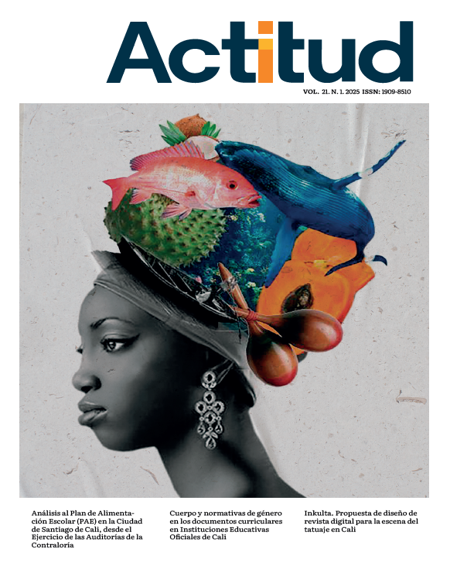Inkulta. Digital magazine design proposal for the Cali tattoo scene
Inkulta. Propuesta de diseño de revista digital para la escena del tatuaje en Cali
Main Article Content
This article collects the results of an investigation about the history of tattoo culture in Cali, in a process of investigation, compilation and reconstruction of memory. The systematization of the information led to the development of an editorial proposal that can serve as a dissemination and communication tool between the different actors in the tattoo scene in the city. A digital magazine that seeks to publicize elements of the history but at the same time of the current situation of the world of tattooing in Cali, that allows options for exchanging knowledge, that can be taken as a means of communication and information and that puts on the table discussion topics that contribute to the growth, strengthening and recognition of this artistic practice, implementing the Double Diamond model in the qualitative research and creation process, reaching the final result of the prototype of the Inkulta digital magazine proposal.
Article Details
Alcaldía de Santiago de Cali. (2020). Plan de Desarrollo 2020-2023. https://www.cali.gov.co/documentos/3253/plan-de-desarrollo--2020---2023/genPagDocs=3
Bhaskaran, L. (2006). ¿Qué es el diseño editorial? Index Book S. L. https://es.scribd.com/document/527387774/BHASKARAN-L-Que-Es-El-Diseno-Editorial
De Zan, J. (2008). Memoria e identidad. Tópicos Revista de Filosofía de Santa Fe, 16, 41-67. https://www.redalyc.org/articulo.oa?id=28815531003
Desing Council. (2025). Framework for innovation. https://www.designcouncil.org.uk/our-resources/framework-for-innovation/
Hernández, R., Fernández, C., & Baptista, M. (2014). Metodología de la Investigación. McGraw Hill.
Herrera, L. (2017). Sistemas visuales de orden plasmados sobre el cuerpo: análisis de las representaciones de modificaciones corporales presentes en la cerámica antropomorfa de la cultura prehispánica Ylama (Trabajo de grado). Universidad del Valle. https://hdl.handle.net/10893/10291
Joya Naranjo, P. A. (2024). Entre tintas y agujas. La carrera de tatuador en la ciudad de Cali. Nexus, (35), e30113183. https://doi.org/10.25100/n.v0i35.13183
Mariandre. (s. f.). Mapa - Modelo Doble Diamante PDF. Scribd. https://es.scribd.com/document/483461394/Mapa-Modelo-Doble-Diamante-pdf
Muñiz Madruga, M. y Aza Blanc, G. (2019). Psicología del tatuaje. Comillas Universidad Pontificia. https://repositorio.comillas.edu/xmlui/bitstream/handle/11531/31802/TFGPsico-MuAizMadruga,Marta.pdf?sequence=1
Medina Pérez, M. y Escalona Velázquez, A. (2012). La memoria cultural como símbolo social de preservación identitaria. Contribuciones a las Ciencias Sociales, enero 2012. www.eumed.net/rev/cccss/17/
Mejía, C. & Londoño, N. (2015). El tatuaje como posible objeto de interposición en el ámbito laboral y social (Trabajo de grado). Universidad Javeriana Bogotá. http://hdl.handle.net/10554/18442
Ospina, Y. (2016, septiembre 4). ¿Qué hay detrás del “boom” del tatuaje en Cali? El País. https://www.elpais.com.co/cali/que-hay-detras-del-boom-del-tatuaje-en.html
Quintana Peña, A. (2006). Metodología de investigación científica cualitativa. En Quintana Peña, A. y Montgomery, W. (Eds.) Psicología tópicos de actualidad, (pp. 65-73). UNMSM.
Urrea Giraldo, F., & Candelo Álvarez, A. F. (2017). Cali, ciudad región ampliada: una aproximación desde la dimensión étnica-racial y los flujos poblacionales. Sociedad Y Economía, (33). https://doi.org/10.25100/sye.v0i33.5628
Zamora, D. (2020, febrero 2). Así se formó la industria del tatuaje en Colombia. Revista Diners. https://revistadiners.com.co/tendencias/55839_tatuajes-el-camino-de-la-tinta/



 Perfil Google Scholar
Perfil Google Scholar





